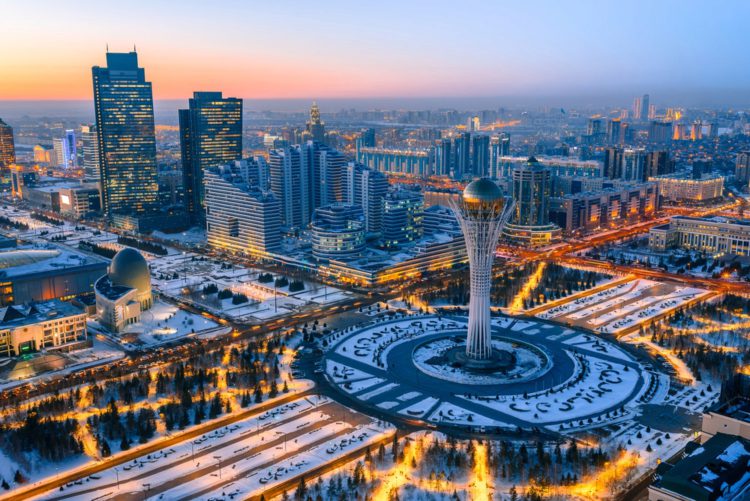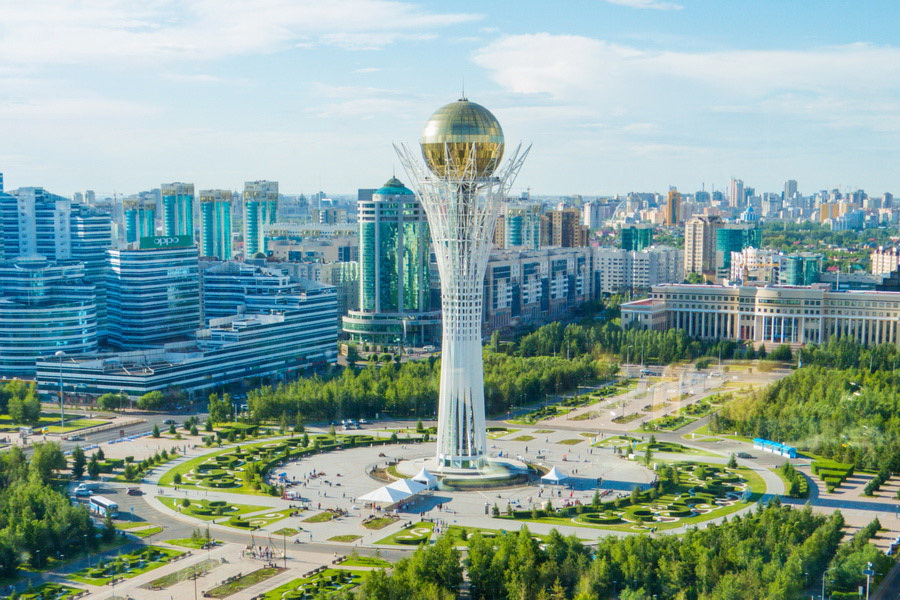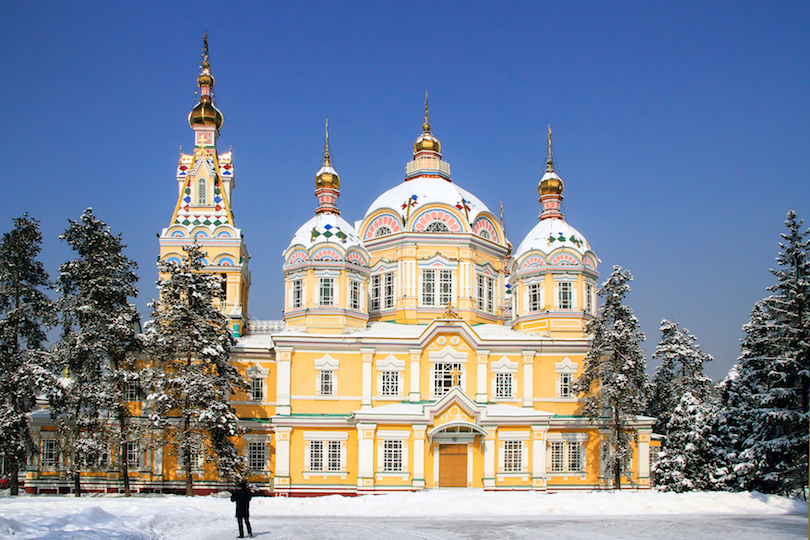
Vast, enigmatic, and endlessly captivating, Kazakhstan is a land of superlatives. As the world’s largest landlocked country and the ninth-largest nation overall, it stretches from the Caspian Sea to the Altai Mountains, encompassing a breathtaking diversity of landscapes, cultures, and histories. For too long, this Central Asian gem remained off the radar for many international travelers, but its rising star is undeniable. With futuristic metropolises, ancient Silk Road cities, towering mountains, arid steppes, and surreal natural wonders, Kazakhstan offers an adventure unlike any other. This article delves into the top attractions, rich history, essential travel tips, accommodation, transportation, and the best time to visit this fascinating country, inviting you to discover the true heart of Central Asia.
Top Attractions: A Kaleidoscope of Wonders
Kazakhstan’s attractions are as diverse as its geography, offering something for every type of traveler, from urban explorers to nature enthusiasts and history buffs.

Related Articles about Kazakhstan: Unveiling the Heart of Central Asia:
- Croatia: A Sun-Kissed Symphony of History, Nature, and Coastal Charm
- Paradise Found: Unveiling the Best of Hawaii – Hotels, Attractions, and Travel Tips
- Discovering Germany: A Journey Through History, Culture, and Landscapes
- Krabi: Thailand’s Andaman Jewel – A Comprehensive Travel Guide
- Discover the Emerald Isle: A Comprehensive Guide to Sri Lanka’s Top Attractions
1. Nur-Sultan (Astana): The Futuristic Capital
Kazakhstan’s capital, renamed Nur-Sultan in 2019 (formerly Astana), is a shimmering testament to modern ambition rising from the northern steppe. This city is an architectural playground, where audacious designs push the boundaries of urban planning.
- Bayterek Tower: The iconic symbol of Nur-Sultan, this 97-meter-tall monument represents a mythical tree of life. Visitors can ascend to the golden orb at the top for panoramic city views and place their hand in the gilded imprint of President Nazarbayev’s palm, believed to grant wishes.
- Khan Shatyr Entertainment Center: Designed by Norman Foster, this giant transparent tent is an architectural marvel. It houses shops, restaurants, a miniature golf course, and even an indoor beach resort with sand imported from the Maldives.
- Palace of Peace and Reconciliation: Another Foster masterpiece, this pyramid-shaped structure is a unique venue for interfaith dialogue, housing an opera house and conference facilities, symbolizing peace and harmony.
- Hazret Sultan Mosque: One of Central Asia’s largest mosques, its gleaming white marble and intricate turquoise domes are a sight to behold, especially when illuminated at night.
- National Museum of Kazakhstan: Offering an insightful journey through the country’s rich history, from ancient nomadic tribes to its modern independence.

2. Almaty: The Southern Capital and Mountain Gateway
Nestled at the foot of the Trans-Ili Alatau mountains, Almaty is Kazakhstan’s largest city and its cultural heart. Known for its tree-lined streets, vibrant atmosphere, and proximity to stunning natural landscapes, it’s often considered the more charming of the two major cities.
- Medeu Skating Rink & Shymbulak Ski Resort: Just a short drive from the city, Medeu is the world’s highest-altitude outdoor speed skating rink. Further up the valley, Shymbulak offers world-class skiing and snowboarding in winter and breathtaking mountain views and hiking in summer.
- Big Almaty Lake (BAO): A stunning alpine lake with striking turquoise waters, surrounded by majestic peaks. It’s a popular spot for day trips and offers incredible photo opportunities, though access can be restricted at times.
- Kok Tobe Hill: Accessible by a scenic cable car, this hill offers panoramic views of Almaty, especially beautiful at sunset. It features a variety of attractions including a mini-zoo, restaurants, and a TV tower.
- Panfilov Park & Zenkov Cathedral: A peaceful urban oasis, the park is home to the Ascension Cathedral (Zenkov Cathedral), a magnificent Russian Orthodox church built entirely of wood without a single nail. It’s a vibrant reminder of the city’s diverse past.
- Green Bazaar: A bustling central market where you can experience local life, sample traditional Kazakh foods, and buy everything from fresh produce to spices, clothing, and souvenirs.
3. Natural Wonders: Beyond the Urban Sprawl
Kazakhstan’s natural landscapes are its crown jewels, offering surreal beauty and unparalleled adventure.
- Charyn Canyon: Often dubbed the "Grand Canyon of Central Asia," Charyn Canyon is a breathtaking natural monument, particularly its "Valley of Castles." Erosion by wind and water has carved dramatic red sandstone formations over millions of years, creating a landscape that feels otherworldly.
- Kolsai Lakes & Kaindy Lake: Tucked away in the Tien Shan mountains, the Kolsai Lakes are a series of three pristine alpine lakes, renowned for their clear waters and surrounding pine forests, perfect for hiking and horse riding. Nearby, Kaindy Lake is famous for its submerged forest, where the trunks of spruce trees rise eerily from its turquoise waters, a result of an earthquake in 1911.
- Altyn Emel National Park: This vast national park is home to several geological wonders. The Singing Dunes (Aigai Kum) produce a low hum when the wind blows across them, a mysterious phenomenon. The Aktau Mountains are a kaleidoscope of colorful chalk formations in shades of red, white, and yellow, while the Katutau Mountains offer a dramatic, rugged landscape of volcanic rock.
- Aksu-Zhabagly Nature Reserve: Kazakhstan’s oldest nature reserve, a UNESCO Biosphere Reserve, is a sanctuary of biodiversity. It’s home to snow leopards, brown bears, and a stunning array of plant life, including wild tulips, making it a paradise for trekkers and nature photographers.
4. Historical and Spiritual Sites: Echoes of the Silk Road
Kazakhstan’s strategic location on the ancient Silk Road has imbued it with a rich historical tapestry.
- Mausoleum of Khoja Ahmed Yasawi (Turkistan): A UNESCO World Heritage site, this magnificent mausoleum in the city of Turkistan is a masterpiece of Timurid architecture. Built in the late 14th century, it honors the Sufi mystic Khoja Ahmed Yasawi and served as a major pilgrimage site, solidifying Turkistan’s role as the spiritual heart of the Kazakh people.
- Tamgaly Petroglyphs: Another UNESCO site, the Tamgaly Gorge features a remarkable collection of ancient rock carvings (petroglyphs) dating back to the Bronze Age. These intricate depictions of sun-headed figures, animals, and human scenes offer a fascinating glimpse into the beliefs and daily lives of ancient nomadic tribes.
- Baikonur Cosmodrome: For those with a fascination for space exploration, a visit to the Baikonur Cosmodrome is an unparalleled experience. The world’s first and largest operational space launch facility, it’s where Yuri Gagarin launched into space. While access requires special permits and arrangements, witnessing a rocket launch from this historic site is truly unforgettable.
A Journey Through Time: Kazakhstan’s Rich History
Kazakhstan’s history is as vast and complex as its geography, shaped by nomadic empires, Silk Road trade, and powerful geopolitical forces. For millennia, its boundless steppes were home to various nomadic tribes, including the Scythians and later the Turkic Khaganates, who left behind a legacy of kurgan burial mounds and petroglyphs.
The 13th century saw the arrival of the Mongol Empire under Genghis Khan, which profoundly influenced the region. Following the collapse of the Golden Horde, the Kazakh Khanate emerged in the 15th century, marking the birth of a distinct Kazakh national identity and statehood. This period saw the development of a unique nomadic culture, characterized by yurts, horse riding, and oral traditions.
From the 18th century onwards, the Russian Empire gradually expanded its influence into Central Asia, leading to the annexation of Kazakh lands. This brought an end to the traditional nomadic lifestyle for many, with the introduction of sedentary agriculture and Russian administration. The Soviet era, beginning in 1920, brought significant changes, including collectivization, industrialization, and devastating famines in the 1930s. Kazakhstan also became a key site for Soviet nuclear weapons testing (Semipalatinsk) and the location of the Baikonur Cosmodrome.
On December 16, 1991, Kazakhstan declared its independence, embarking on a new chapter as a sovereign nation. Since then, it has transformed into a modern state, leveraging its vast oil and gas reserves to develop its economy and build ambitious new cities like Nur-Sultan, while carefully preserving its nomadic heritage and unique cultural identity.
Travel Tips for the Modern Explorer
Venturing into Kazakhstan is an exciting prospect, but a few practical tips can make your journey smoother and more enjoyable.
- Visa Requirements: Kazakhstan has a liberal visa policy, offering visa-free travel for citizens of many countries, including the EU, USA, Canada, UK, Australia, and many others, for periods typically ranging from 15 to 90 days. Always check the latest requirements for your nationality before travel.
- Language: Kazakh is the state language, but Russian is widely spoken, especially in cities and as a lingua franca among different ethnic groups. English is becoming more common in tourist areas, major hotels, and among younger generations, but learning a few basic Russian or Kazakh phrases will be highly appreciated.
- Currency: The local currency is the Kazakhstani Tenge (KZT). ATMs are readily available in cities, and credit cards are accepted in most major establishments. It’s advisable to carry some cash for smaller purchases and rural areas.
- Safety: Kazakhstan is generally a safe country for tourists. Standard precautions against petty crime (pickpocketing in crowded areas) are advisable. Be aware of traffic, as road rules can sometimes be flexible.
- Culture & Etiquette: Kazakhs are known for their hospitality. When visiting homes, it’s customary to bring a small gift. Dress modestly when visiting religious sites. Respect for elders is deeply ingrained in the culture.
- Connectivity: SIM cards are inexpensive and easily acquired with a passport. Mobile data coverage is generally good in cities and along major routes. Wi-Fi is common in hotels, cafes, and restaurants.
- Health: Ensure you have comprehensive travel insurance. Tap water is generally not safe to drink; stick to bottled water. Consult your doctor about recommended vaccinations.
- Packing: Pack layers, as temperatures can vary significantly between day and night, and between regions. Comfortable walking shoes are essential, especially for exploring cities and natural parks. Sun protection (hat, sunglasses, sunscreen) is crucial, as is an adapter for Type C/F plugs.
Accommodation Options: From Yurts to Luxury
Kazakhstan offers a growing range of accommodation options to suit all budgets and preferences.
- Luxury Hotels: In Nur-Sultan and Almaty, you’ll find international chains like The Ritz-Carlton, St. Regis, Marriott, and Hilton, offering world-class amenities and services. These cater to business travelers and those seeking opulent comfort.
- Mid-Range Hotels: Numerous local and boutique hotels provide comfortable stays with good amenities at reasonable prices. Serviced apartments are also a popular choice, offering more space and flexibility, especially for longer stays.
- Budget Accommodation: Hostels are increasingly common, particularly in Almaty, providing affordable dormitory beds and private rooms, often with a social atmosphere. Guesthouses and homestays are excellent options, especially in smaller towns and near national parks, offering a more authentic local experience.
- Unique Stays: For an unforgettable cultural immersion, consider staying in a traditional Kazakh yurt (yurta). These nomadic dwellings, often found in national parks like Altyn Emel or near the Kolsai Lakes, offer a glimpse into the traditional Kazakh way of life, often with basic amenities but an unparalleled connection to nature.
Getting Around: Navigating the Vast Landscapes
Traveling across Kazakhstan’s immense distances requires a combination of transportation methods.
- International Flights: The primary international gateways are Nur-Sultan International Airport (NQZ) and Almaty International Airport (ALA). Air Astana, the national carrier, offers excellent service and connects Kazakhstan to major cities worldwide.
- Domestic Flights: For covering long distances quickly, domestic flights are the most efficient option. Air Astana, SCAT Airlines, and the budget airline FlyArystan operate frequent services between major cities like Nur-Sultan, Almaty, Shymkent, and Aktau.
- Trains: Kazakhstan Temir Zholy (KTZ) operates a comprehensive rail network. Trains are a comfortable and often scenic way to travel between cities, with options ranging from modern high-speed trains to traditional overnight sleepers. For example, the journey from Almaty to Turkistan is a popular overnight route.
- Buses and Marshrutkas: Inter-city buses and marshrutkas (shared minibuses) are cheaper alternatives for shorter to medium distances but can be less comfortable and slower than trains.
- Taxis: Taxis are readily available in cities. It’s highly recommended to use ride-hailing apps like Yandex Go to ensure fair pricing and avoid potential language barriers.
- Car Rental: While car rental is an option, it’s generally not recommended for first-time visitors due to varying road conditions, signage in Cyrillic, and potentially aggressive driving outside major cities. For exploring national parks and remote areas, it’s often better to hire a car with a local driver or join an organized tour.
Best Time to Visit: Seasons of Splendor
Kazakhstan experiences distinct seasons, each offering a different charm. The best time to visit largely depends on your interests.
- Spring (April-May): This is arguably one of the best times to visit. The weather is mild and pleasant, the steppe comes alive with blooming wildflowers (including wild tulips), and the mountains shed their winter snow, making it ideal for hiking and city sightseeing before the summer heat.
- Summer (June-August): Summer is warm to hot, particularly in the cities and southern regions. It’s the peak season for mountain activities like trekking, climbing, and exploring the high-altitude lakes. While cities can be quite warm, the mountains offer a refreshing escape.
- Autumn (September-October): Another excellent time to visit, with comfortable temperatures, fewer crowds, and stunning fall foliage in the mountains, especially around Almaty. The light is often beautiful for photography.
- Winter (November-March): Winters are cold and snowy, especially in Nur-Sultan, which is one of the coldest capitals in the world. However, it’s the perfect time for winter sports enthusiasts, with Shymbulak Ski Resort offering excellent conditions. Many natural attractions become inaccessible due to snow, but the cities take on a festive, snowy charm.
Conclusion: A Journey into the Unknown
Kazakhstan is a land of captivating contrasts and boundless potential. From the architectural marvels of Nur-Sultan to the alpine splendor of Almaty and the ancient whispers of the Silk Road in Turkistan, it offers an immersive experience for every traveler. Its vast natural landscapes, rich nomadic history, and burgeoning modern identity create a unique tapestry waiting to be explored. As it continues to open its doors to the world, Kazakhstan promises not just a trip, but an unforgettable journey into the heart of Central Asia, challenging perceptions and leaving visitors with a profound sense of wonder and discovery. Don’t just travel; uncover the magic of Kazakhstan.





